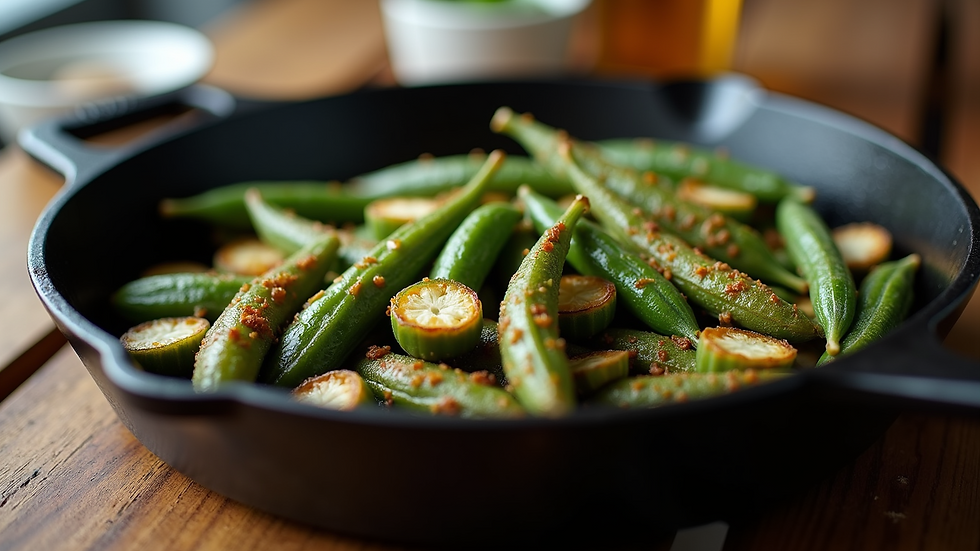The Historical Roots of Southern Cuisine
- Bake Braise & Blaze
- 20 hours ago
- 4 min read
Southern cuisine is a rich tapestry woven from diverse cultural influences, local ingredients, and centuries of tradition. Its flavors tell stories of the people and places that shaped the American South. Understanding the historical roots of this beloved cuisine offers a deeper appreciation for its unique dishes and cooking methods. This article delves into the origins of southern culinary heritage, tracing the journey from indigenous foods to the fusion of cultures that created the vibrant food culture we enjoy today.
The Foundations of Southern Culinary Heritage
Southern cuisine is deeply rooted in the agricultural bounty and cultural diversity of the region. The fertile lands of the South provided an abundance of crops such as corn, beans, and squash, which were staples for Native American tribes long before European settlers arrived. These indigenous ingredients laid the groundwork for many traditional dishes.
When European colonists settled in the South, they brought with them their own food traditions, including English, Scottish, and French influences. These were combined with African culinary practices introduced by enslaved people, who contributed techniques, spices, and ingredients that became essential to southern cooking.
Some key elements that define southern culinary heritage include:
Use of local ingredients: Cornmeal, okra, sweet potatoes, and collard greens.
Cooking techniques: Slow cooking, frying, and smoking.
Flavor profiles: Bold, savory, and often spicy.
This blend of Native American, European, and African influences created a cuisine that is both comforting and complex.

The Role of African Influence in Southern Cuisine
One cannot discuss southern culinary heritage without acknowledging the profound impact of African culture. Enslaved Africans brought with them knowledge of rice cultivation, seasoning blends, and cooking methods that transformed southern food.
For example, dishes like gumbo and jambalaya have clear African roots, combining local ingredients with African spices and cooking styles. The use of okra, a vegetable native to Africa, became a staple in many southern recipes. Additionally, the technique of deep frying, which is now synonymous with southern comfort food, was popularized through African culinary traditions.
African influence also introduced the concept of "one-pot meals," which were practical and flavorful, making use of available ingredients and maximizing taste. This approach is evident in dishes such as:
Chitlins: Fried pig intestines, a resourceful use of available meat.
Cornbread: A staple bread made from cornmeal, often cooked in cast iron skillets.
These dishes highlight the resilience and creativity of African Americans in shaping southern cuisine.

The Influence of European Settlers and Immigrants
European settlers brought their own culinary traditions, which blended with indigenous and African influences to create the southern food landscape. The English introduced biscuits and pies, while the French contributed techniques like roux-making, essential for dishes like gumbo.
Scots-Irish immigrants brought hearty stews and the use of preserved meats, which were adapted to the southern environment. German settlers introduced sausages and pickling methods, enriching the variety of flavors and preservation techniques.
The combination of these European influences with local ingredients led to the development of iconic southern dishes such as:
Fried chicken: A dish with Scottish origins, perfected in the South.
Pecan pie: Utilizing native pecans in a sweet dessert.
Barbecue: A slow-cooked meat tradition influenced by European smoking techniques.
This fusion of cultures created a dynamic culinary heritage that continues to evolve.

The Impact of Geography and Agriculture on Southern Cuisine
The geography of the South played a crucial role in shaping its cuisine. The warm climate and fertile soil allowed for diverse agriculture, which influenced the availability of ingredients and seasonal dishes.
The Mississippi Delta, for example, was ideal for growing cotton and rice, while the Appalachian Mountains provided wild game and fresh water fish. Coastal areas offered seafood like shrimp, crab, and catfish, which became staples in southern cooking.
Farmers and home cooks adapted their recipes based on what was locally available, leading to regional variations such as:
Lowcountry cuisine: Emphasizing seafood and rice dishes.
Creole cooking: A blend of French, Spanish, African, and Caribbean flavors.
Soul food: Rooted in African American traditions, focusing on hearty, flavorful dishes.
Understanding the connection between geography and food helps explain the diversity within southern cuisine.
Preserving and Celebrating Southern Culinary Heritage Today
Today, southern cuisine continues to thrive, celebrated in homes, restaurants, and festivals across the region. Chefs and food historians work to preserve traditional recipes while also innovating and adapting to modern tastes.
For those interested in exploring the roots of southern cooking, consider these practical steps:
Visit local farmers' markets: Support regional agriculture and discover fresh, seasonal ingredients.
Try traditional recipes: Start with classics like cornbread, collard greens, or shrimp and grits.
Learn cooking techniques: Master slow cooking, frying, and seasoning to capture authentic flavors.
Explore food history: Read about the southern cuisine history to understand the cultural context behind dishes.
By embracing both tradition and innovation, southern culinary heritage remains a vibrant and evolving part of American food culture.
Southern cuisine is more than just food - it is a reflection of history, culture, and community. Its roots run deep, connecting generations through shared meals and stories. Whether you are a seasoned cook or a curious foodie, exploring the historical roots of southern cuisine offers a delicious journey into the heart of the South.








Comments